Low-Cost Ka-Band Satellite Receiver Data Preprocessing for Tropospheric Propagation Studies
Abstract
:1. Introduction
2. Materials and Methods
2.1. Experimental Setup
2.1.1. The RF Outdoor Unit
2.1.2. The Indoor Unit
2.2. Extraction of the Daily Template
- 1.
- Three days of data selection: time synchronized beacon and meteorological data of the previous, current, and next days;
- 2.
- Outlier detection based on the standard deviation of the mean value of the raw data: These mean values were computed using a 2 min moving average filter. When the difference between the beacon level and its moving average is larger than the standard deviation multiplied by a coverage factor, then the sample is recognized as an outlier and flagged as invalid data. In this work, a coverage factor of 5 was used;
- 3.
- Detection of abnormal amplitude changes (exceeding a defined threshold) from one sample to another: In this study, the samples exceeding a threshold of 1 were considered as spikes and flagged as invalid data;
- 4.
- Identification of rainy periods: Data corresponding to rain events are flagged as invalid data;
- 5.
- A repair operation: Missing and invalid data are replaced by linear interpolation from the valid data;
- 6.
- After having inspected and repaired the selected data, template extraction itself is performed. To identify the template, we performed a low-pass filter processing that should be able to follow the fairly slow changes in water vapor in the atmosphere, with time constants of hours, and the presence of clouds, with time constants faster, but still slower than rain. In addition, we had to follow both the combined effect of receive antenna mispointing plus satellite orbit perturbation and the LNB gain oscillations due to the thermal variations, which clearly have a full one-day duration. The template was computed with an FFT by considering only those components whose period was longer than 8 min. Several tests were carried out, and this seemed to be the optimum value in our case.
3. Results
4. Conclusions
Author Contributions
Funding
Institutional Review Board Statement
Informed Consent Statement
Data Availability Statement
Acknowledgments
Conflicts of Interest
Abbreviations
| a.m.s.l. | above mean sea level |
| ASI | Agenzia Spaziale Italiana (Italian Space Agency) |
| CDF | Cumulative Distribution Function |
| EIRP | Equivalent Isotropically Radiated Power |
| ESA | European Space Agency |
| FFT | Fast Fourier Transform |
| GNSS | Global Navigation Satellite System |
| IF | Intermediate Frequency |
| LNB | Low-Noise Block |
| METAR | METeorological Aerodrome Report |
| N | Noise |
| PC | Personal Computer |
| RF | Radio Frequency |
| RH | Relative Humidity |
| S | Received Beacon Signal |
| SDR | Software-Defined Radio |
| SNR | Signal-power-to-Noise-power Ratio |
| USB | Universal Serial Bus |
References
- Machado, F.; Pérez Fontán, F.; Pastoriza, V.; Marino, P. The Ka and Q band AlphaSAT ground station in Vigo. In Proceedings of the 9th European Conference on Antennas and Propagation (EuCAP), Lisbon, Portugal, 12–17 April 2015; pp. 1–4. [Google Scholar]
- Codispoti, G.; Parca, G.; Ruggieri, M.; Rossi, T.; De Sanctis, M.; Riva, C.; Luini, L. The role of the Italian Space Agency in investigating high frequencies for satellite communications: The Alphasat experiment. Int. J. Satell. Commun. Netw. 2018, 37, 387–396. [Google Scholar] [CrossRef]
- Ventouras, S.; Martellucci, A.; Reeves, R.; Rumi, E.; Fontan, F.P.; Machado, F.; Pastoriza, V.; Rocha, A.; Mota, S.; Jorge, F.; et al. Assessment of spatial and temporal properties of Ka/Q band earth-space radio channel across Europe using Alphasat Aldo Paraboni payload. Int. J. Satell. Commun. Netw. 2019, 37, 477–501. [Google Scholar] [CrossRef]
- Norsat Block Downconverter, Model: BDC-9000XBN. Available online: https://www.norsat.com/products/9000-single-band-ka-band-ext-ref-bdc-4 (accessed on 24 January 2022).
- Maral, G.; Bousquet, M.; Sun, Z. Satellite Communications Systems: Systems, Techniques and Technology, 6th ed.; John Wiley & Sons, Ltd.: Hoboken, NJ, USA, 2020. [Google Scholar]
- International Telecommunication Union Radiocommunication Sector (ITU-R). Recommendation ITU-R S.484-3: Station-Keeping in Longitude of Geostationary Satellites in the Fixed-Satellite Service; ITU-R: Geneva, Switzerland, 1992; Available online: https://www.itu.int/dms_pubrec/itu-r/rec/s/R-REC-S.484-3-199203-I!!PDF-E.pdf (accessed on 24 January 2022).
- International Telecommunication Union Radiocommunication Sector (ITU-R). Recommendation ITU-R P.618-13: Propagation Data and Prediction Methods Required for the Design of Earth-Space Telecommunication Systems; ITU-R: Geneva, Switzerland, 2017; Available online: https://www.itu.int/dms_pubrec/itu-r/rec/p/R-REC-P.618-13-201712-I!!PDF-E.pdf (accessed on 24 January 2022).
- Riva, C.G.; Luini, L. Thermal effects on a 4.2 m center-fed Cassegrain antenna strut in the Alphasat Ka- and Q-/V-band Aldo Paraboni propagation measurements. IEEE Trans. Antennas Propagat. 2018, 66, 3700–3705. [Google Scholar] [CrossRef]
- Riera, J.M.; Siles, G.A.; García-del-Pino, P.; Benarroch, A. Alphasat propagation experiment in Madrid: Processing of the first year of measurements. In Proceedings of the 10th European Conference on Antennas and Propagation (EuCAP), Davos, Switzerland, 10–15 April 2016; pp. 1–5. [Google Scholar]
- Luini, L.; Siles, G.A.; Riera, J.M.; Riva, C.G.; Nessel, J. Methods to estimate gas attenuation in absence of a radiometer to support satellite propagation experiments. IEEE Trans. Instrum. Meas. 2020, 69, 5116–5127. [Google Scholar] [CrossRef]
- Luini, L.; Riva, C.; Capsoni, C.; Martellucci, A. Attenuation in non rainy conditions at millimeter wavelengths: Assessment of a procedure. IEEE Trans. Geosci. Remote Sens. 2007, 45, 2150–2157. [Google Scholar] [CrossRef]
- Luini, L.; Riva, C.; Nebuloni, R.; Mauri, M.; Nessel, J.; Fanti, A. Calibration and use of microwave radiometers in multiple-site EM wave propagation experiments. In Proceedings of the 12th European Conference on Antennas and Propagation (EuCAP), London, UK, 9–13 April 2018; pp. 1–5. [Google Scholar]
- Siles, G.A.; Riera, J.M.; García-del-Pino, P. An application of IGS Zenith tropospheric delay data to propagation studies: Validation of radiometric atmospheric attenuation. IEEE Trans. Antennas Propagat. 2016, 64, 262–270. [Google Scholar] [CrossRef]
- Quibus, L.; Luini, L.; Riva, C.; Vanhoenacker-Janvier, D. Use and accuracy of Numerical Weather Predictions to support EM wave propagation experiments. IEEE Trans. Antennas Propagat. 2019, 67, 5544–5554. [Google Scholar] [CrossRef]
- Outeiral García, M.; Jeannin, N.; Féral, L.; Castanet, L. Use of WRF model to characterize propagation effects in the troposphere. In Proceedings of the 7th European Conference on Antennas and Propagation (EuCAP), Gothenburg, Sweden, 8–12 April 2013; pp. 1377–1381. [Google Scholar]
- Fayon, G.; Féral, L.; Castanet, L.; Jeannin, N.; Boulanger, X. Use of WRF to generate site diversity statistics in south of France. In Proceedings of the 32nd URSI GASS, Montreal, QC, Canada, 19–26 August 2017; pp. 1–4. [Google Scholar]
- Le Mire, V.; Boulanger, X.; Castanet, L.; Benammar, B.; Féral, F. Potentialities of the Numerical Weather Prediction model WRF to produce attenuation statistics in tropical regions. In Proceedings of the 14th European Conference on Antennas and Propagation (EuCAP), Copenhagen, Denmark, 15–20 March 2020; pp. 1–4. [Google Scholar]
- Rocha, A.; Pereira, T.; Mota, S.; Jorge, F. Alphasat experiment at Aveiro. In Proceedings of the 10th European Conference on Antennas and Propagation (EuCAP), Davos, Switzerland, 10–15 April 2016; pp. 1–5. [Google Scholar]
- García-del-Pino, P.; Riera, J.M.; Benarroch, A. Tropospheric scintillation with concurrent rain attenuation at 50 GHz in Madrid. IEEE Trans. Antennas Propagat. 2012, 60, 1578–1583. [Google Scholar] [CrossRef] [Green Version]
- Riva, C.; (Dipartimento di Elettronica, Informazione e Bioingegneria, Politecnico di Milano, Milan, Italy); Willis, M.J.; (STFC Rutherford Appleton Laboratory, Chilton, UK). COST IC0802 Handbook on Measurements and Products, 2014. (Unpublished work).
- Karasawa, Y.; Matsudo, T. Characteristics of fading on low-elevation angle Earth-space paths with concurrent rain attenuation and scintillation. IEEE Trans. Antennas Propagat. 1991, 39, 657–661. [Google Scholar] [CrossRef]
- Boulanger, X.; Gabard, B.; Casadebaig, L.; Castanet, L. Four years of total attenuation statistics of earth-space propagation experiments at Ka-band in Toulouse. IEEE Trans. Antennas Propagat. 2015, 63, 2203–2214. [Google Scholar] [CrossRef]
- Boulanger, X.; Benammar, B.; Castanet, L. Propagation experiment at Ka-band in French Guiana: First year of measurements. IEEE Antennas Wirel. Propag. Lett. 2019, 18, 241–244. [Google Scholar] [CrossRef]
- Luini, L.; Panzeri, A.; Riva, C.G. Enhancement of the Synthetic Storm Technique for the prediction of rain attenuation time series at EHF. IEEE Trans. Antennas Propagat. 2020, 68, 5592–5601. [Google Scholar] [CrossRef]
- Thies Clima, Laser Precipitation Monitor, Model: 5.4110.00.x00. Available online: https://www.thiesclima.com/en/Products/Precipitation-Electrical-devices/ (accessed on 24 January 2022).
- Campbell Scientific, RM Young Tipping Bucket Raingauge, Model: 52202. Available online: https://www.campbellsci.eu/52203 (accessed on 24 January 2022).
- OGIMET. Available online: http://www.ogimet.com/ (accessed on 24 January 2022).
- ALCOMA Parabolic Microwave 2 ft Antenna, Model: UNI2-18. Available online: http://www.al-wireless.com/media/document/uni2-18.pdf (accessed on 24 January 2022).
- Nuand bladeRF USB 3.0 Software Defined Radio, Model: x40. Available online: https://www.nuand.com/bladeRF-brief.pdf (accessed on 24 January 2022).
- Eutelsat KaSat 9A. Provisional Frequency Plan. Available online: http://frequencyplansatellites.altervista.org/Eutelsat/Eutelsat_KaSat_9A.pdf (accessed on 24 January 2022).
- Machado, F.; Vilar, E.; Fontán, F.P.; Pastoriza, V.; Mariño, P. Easy-to-build satellite beacon receiver for propagation experimentation at millimeter bands. Radioengineering 2014, 23, 154–164. [Google Scholar]
- Kikkert, C.J. The design of a Ka band satellite beacon receiver. In Proceedings of the 6th International Conference Information, Communications and Signal Processing (ICICS), Singapore, 10–13 December 2007; pp. 1–5. [Google Scholar]
- Flávio, J.; Rocha, A.; Mota, S.; Jorge, F. Alphasat experiment at Aveiro: Data processing approach and experimental results. In Proceedings of the 11th European Conference on Antennas and Propagation (EuCAP), Paris, France, 19–24 March 2017; pp. 2370–2374. [Google Scholar]
- Vanhoenacker-Janvier, D.; Graziani, A.; Plimon, K.; Schoenhuber, M.; Grootaers, T.; Lechien, L.; Coenegrachts, F.; Soupart, T.; Martellucci, A.; Perez, R.O. An automated data processing system for satellite propagation beacon measurements. In Proceedings of the 7th ESA International Workshop on Tracking, Telemetry and Command Systems for Space Applications (TTC), Noordwijk, The Netherlands, 13–16 September 2017; pp. 1–7. [Google Scholar]
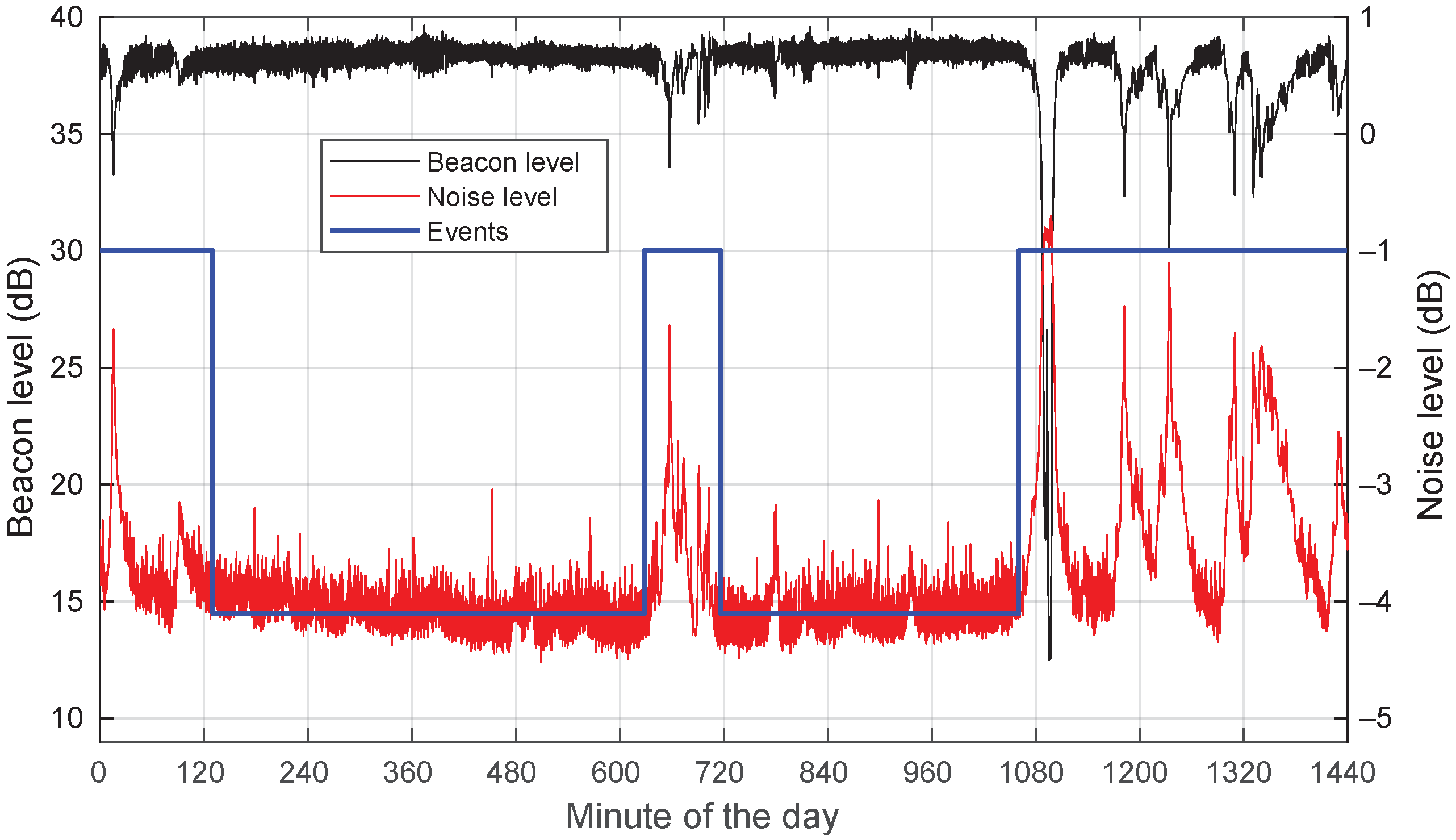


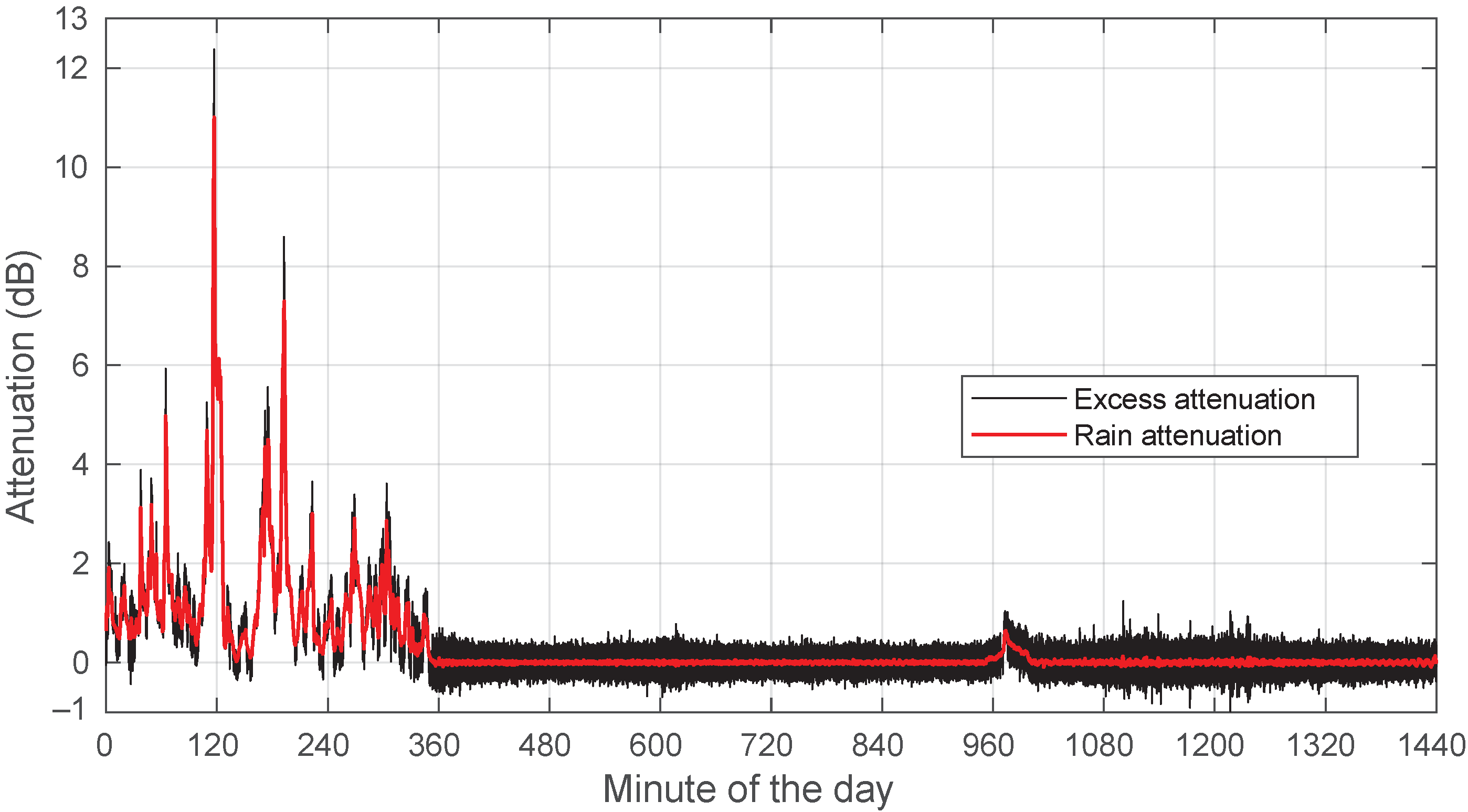


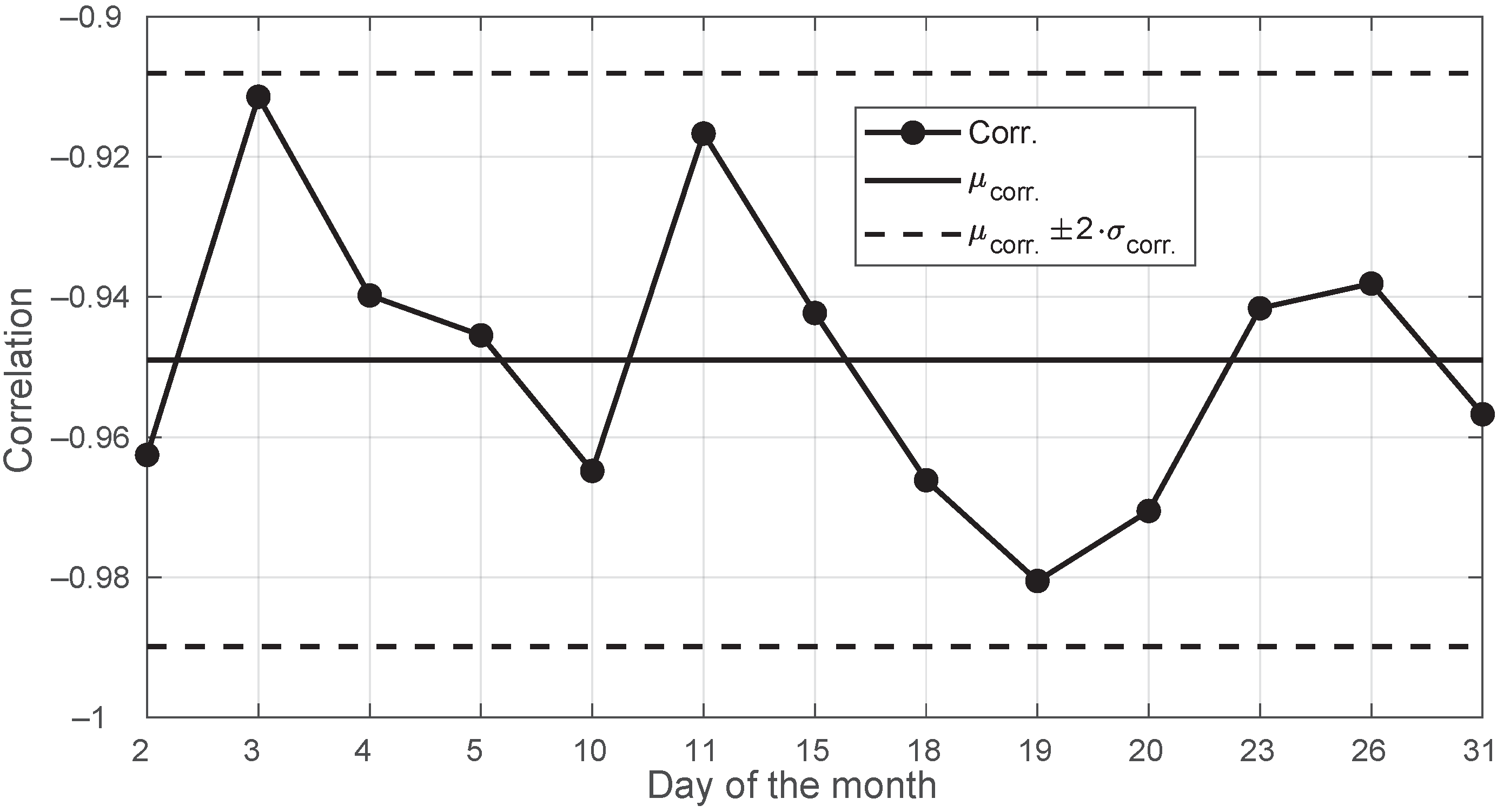
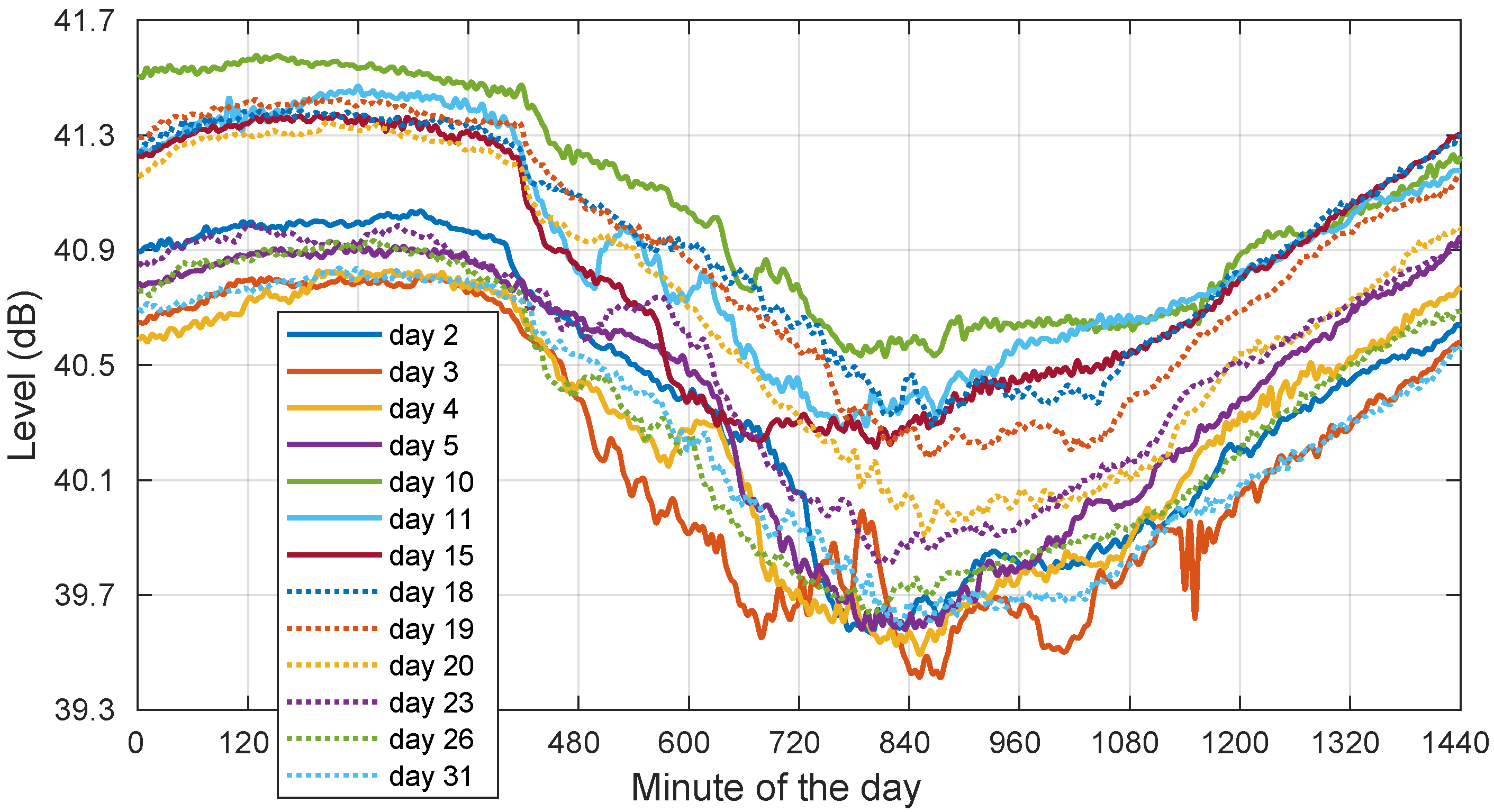
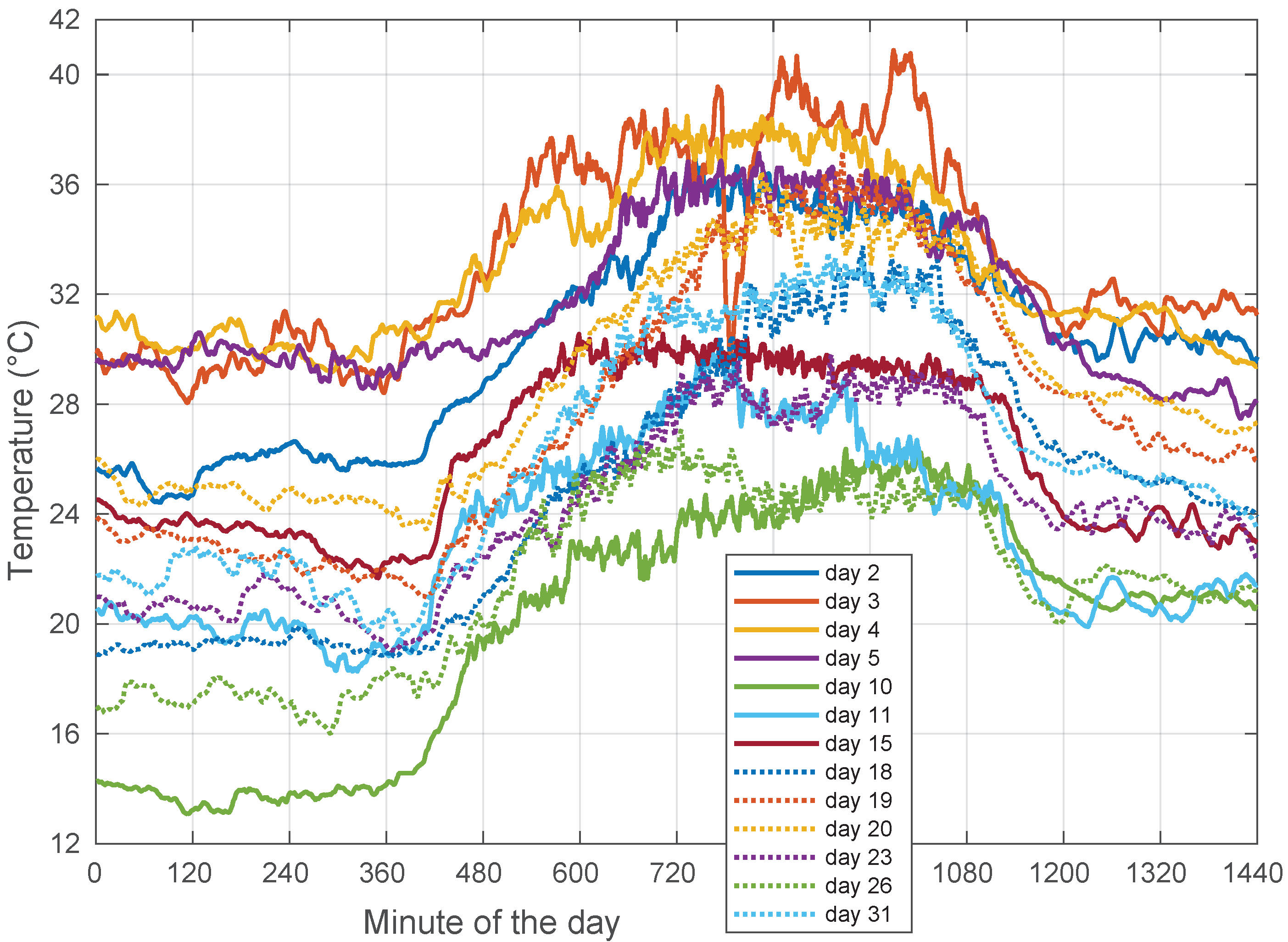
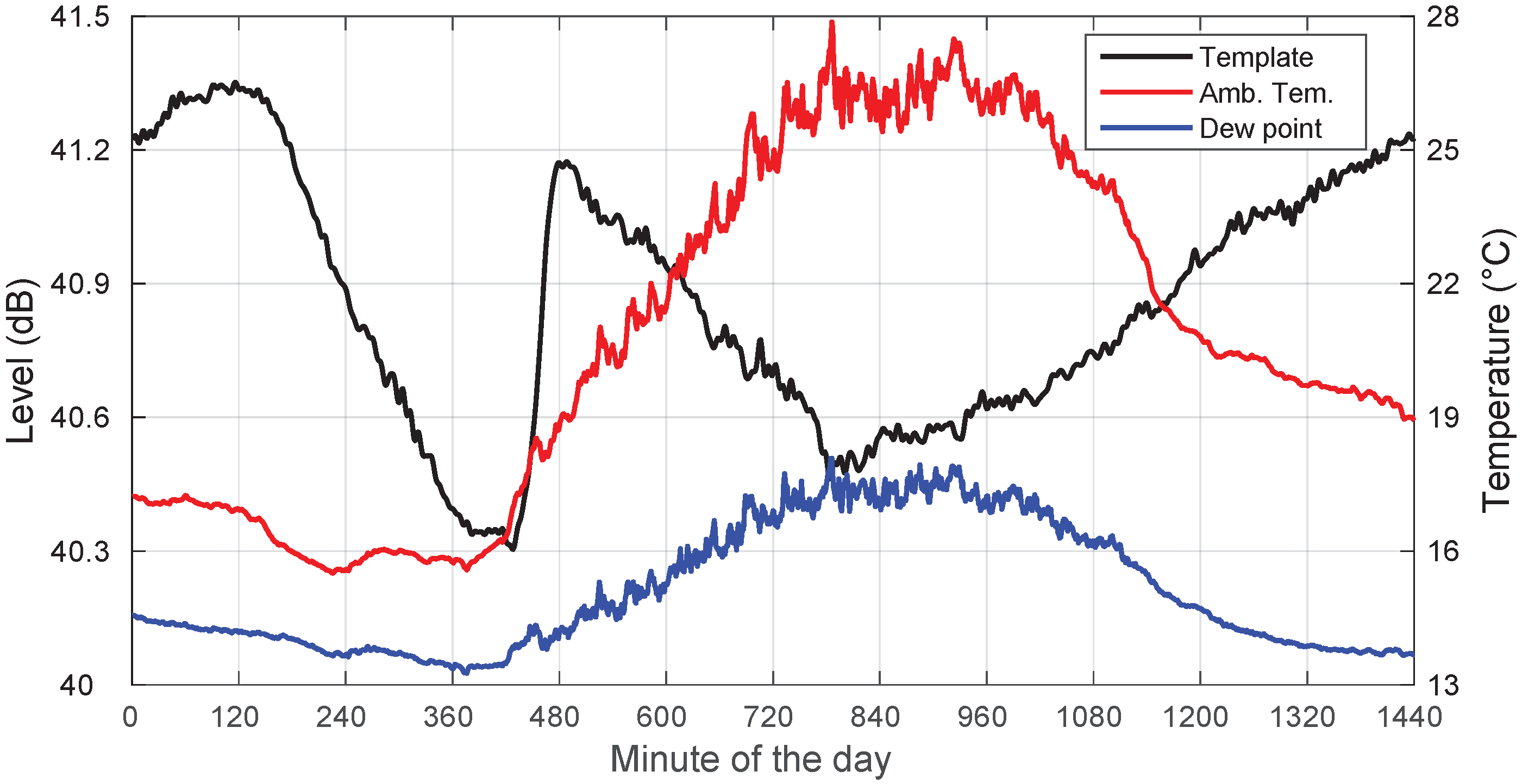
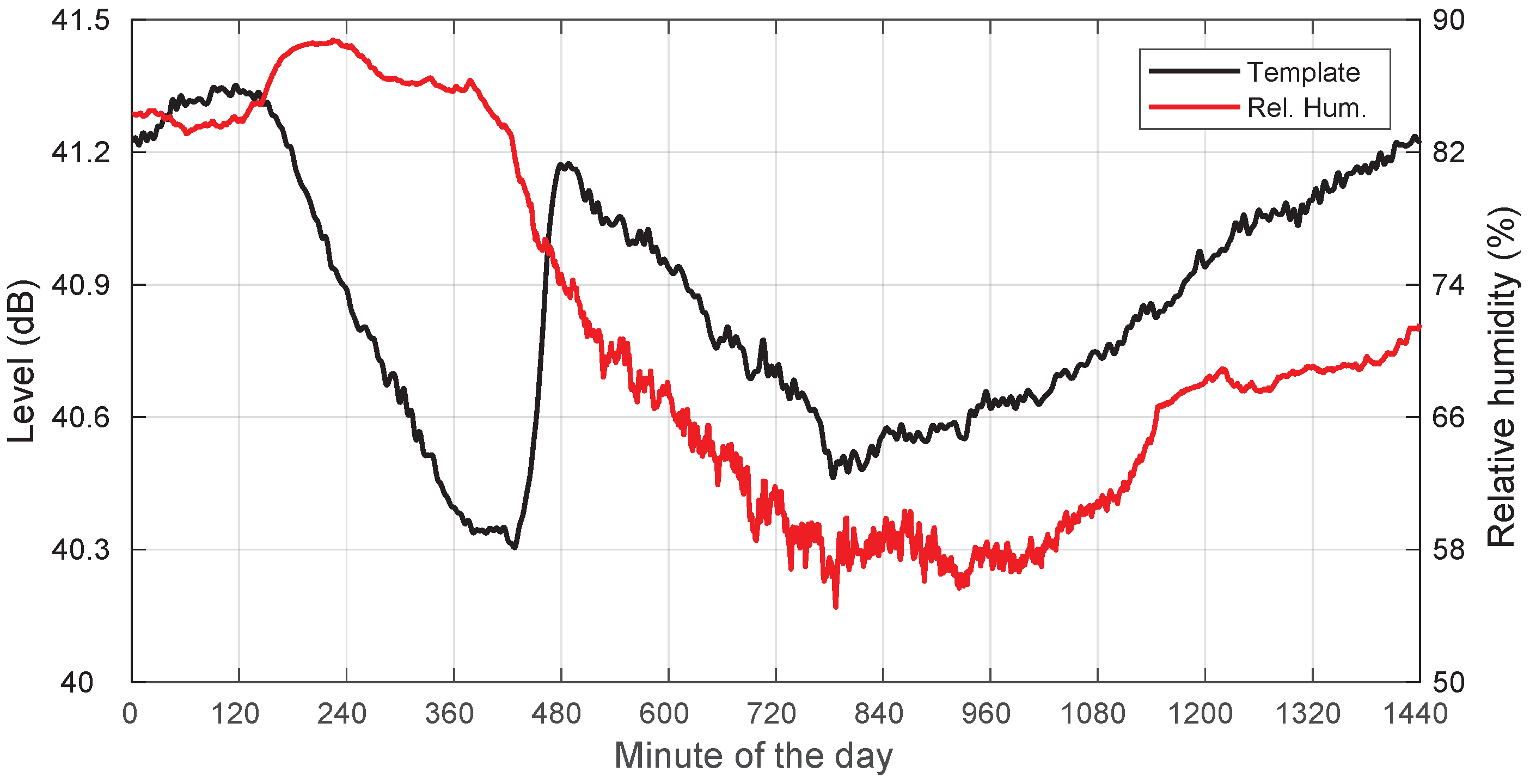
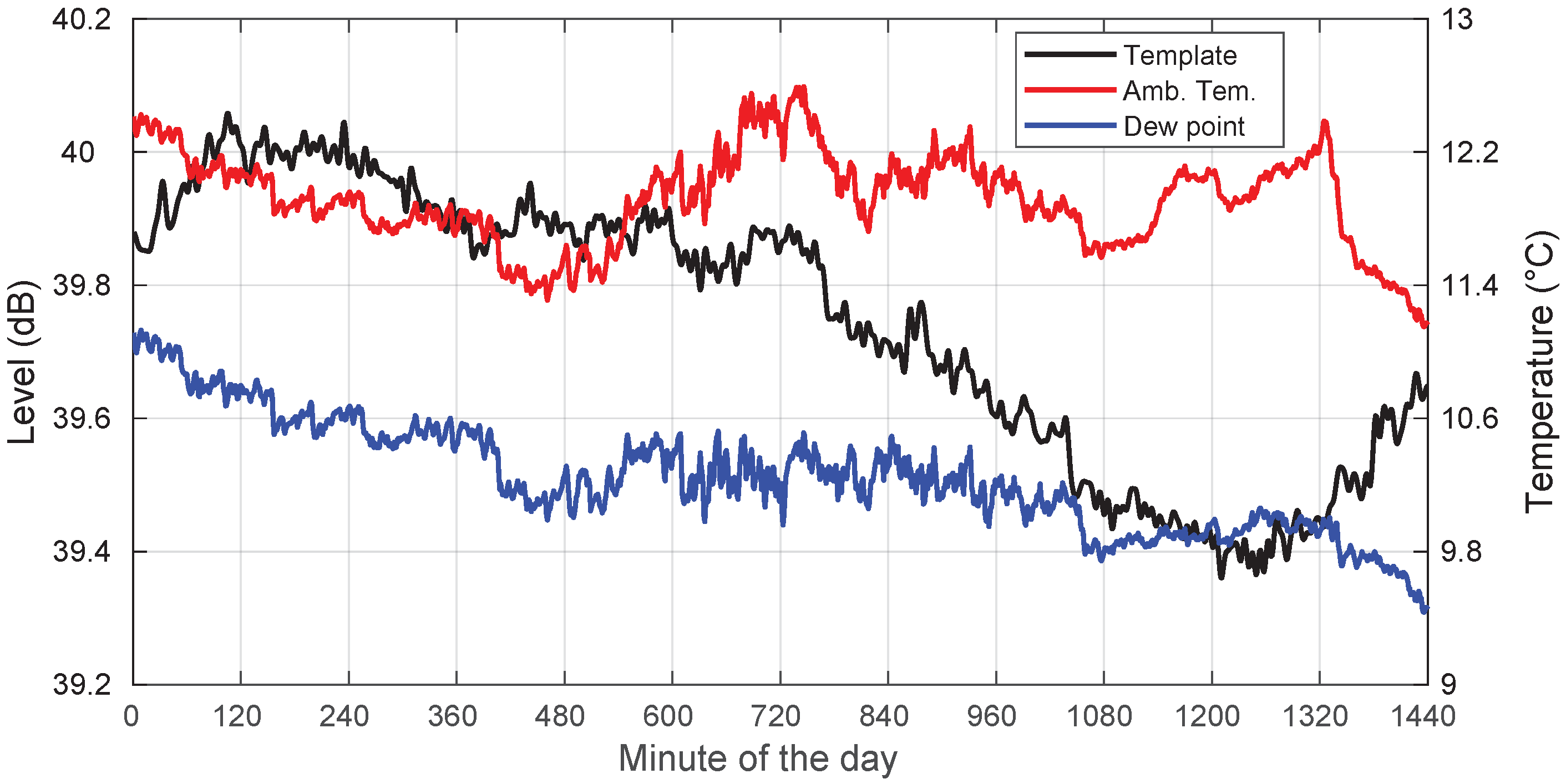
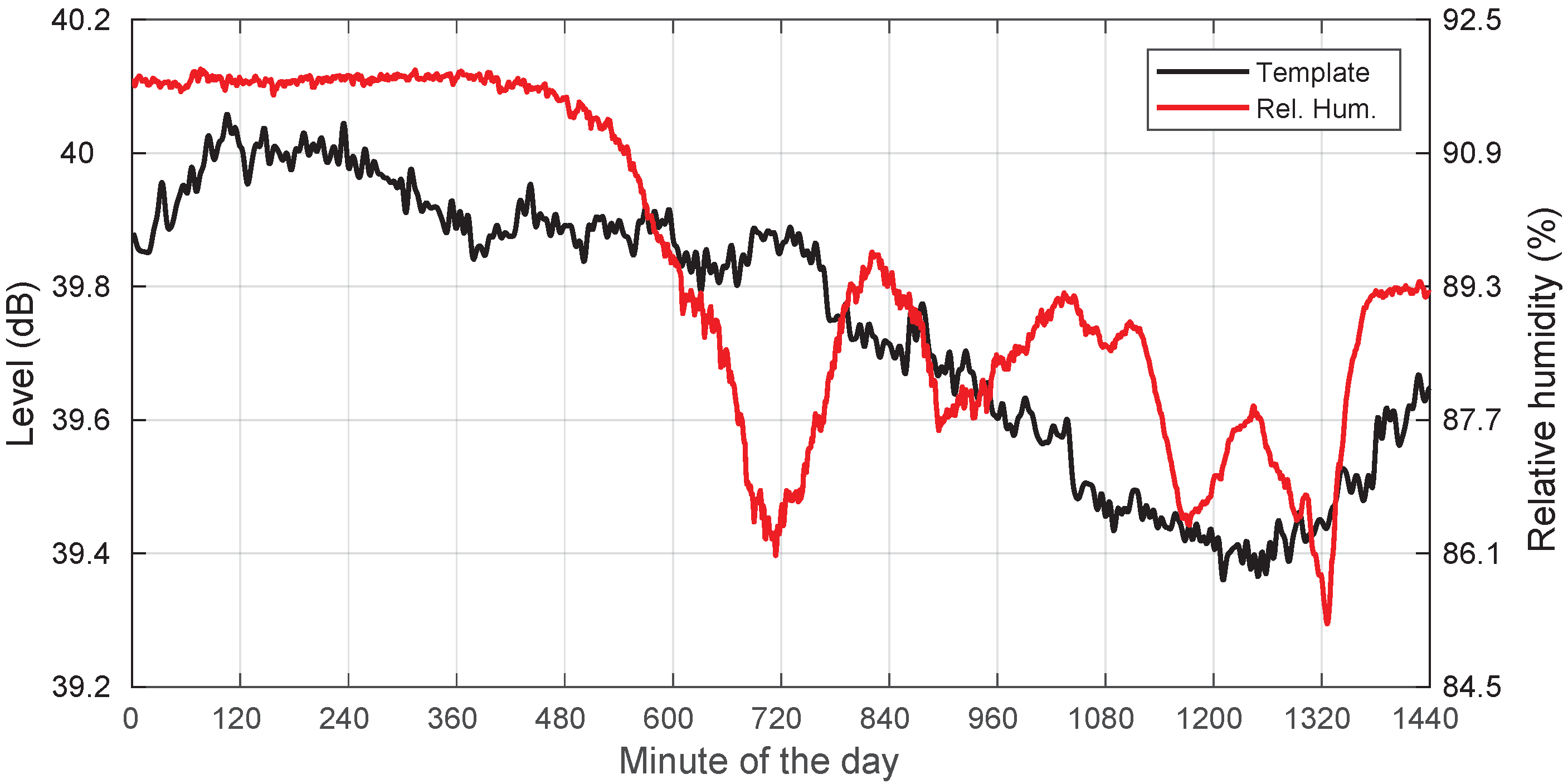
Publisher’s Note: MDPI stays neutral with regard to jurisdictional claims in published maps and institutional affiliations. |
© 2022 by the authors. Licensee MDPI, Basel, Switzerland. This article is an open access article distributed under the terms and conditions of the Creative Commons Attribution (CC BY) license (https://creativecommons.org/licenses/by/4.0/).
Share and Cite
Pastoriza-Santos, V.; Machado, F.; Nandi, D.; Pérez-Fontán, F. Low-Cost Ka-Band Satellite Receiver Data Preprocessing for Tropospheric Propagation Studies. Sensors 2022, 22, 1043. https://doi.org/10.3390/s22031043
Pastoriza-Santos V, Machado F, Nandi D, Pérez-Fontán F. Low-Cost Ka-Band Satellite Receiver Data Preprocessing for Tropospheric Propagation Studies. Sensors. 2022; 22(3):1043. https://doi.org/10.3390/s22031043
Chicago/Turabian StylePastoriza-Santos, Vicente, Fernando Machado, Dalia Nandi, and Fernando Pérez-Fontán. 2022. "Low-Cost Ka-Band Satellite Receiver Data Preprocessing for Tropospheric Propagation Studies" Sensors 22, no. 3: 1043. https://doi.org/10.3390/s22031043






